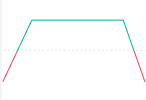What is Neutral Short Strangle?

What is Options Trading?
Before you go headlong into understanding ‘what a short strangle is’ and how a short strangle strategy is implemented, we must establish context. Let us first review the concept of options trading and all its ramifications. Options fall under derivatives - a financial instrument that gets its value from an underlying asset.
When you trade-in options, you do it via contracts that stipulate that the buyer has a right but does not have any obligation to buy or sell an asset before a predetermined date at a given price. This price is called the strike price. Understanding these concepts helps understand how the short strangle option strategy works. At the same time, you need to understand what Market Neutral is to understand short contracts better.
Understanding Market Neutral
Market-Neutral is a strategy that has other strategies like merger arbitrage, shorting sectors, etc. We cannot say that there is just one accepted method of employing a market-neutral strategy. Market-neutral position
By holding a market-neutral position, which can involve 50% long and 50% short positions in any industry, one can exploit any momentum in the market. Market-neutral strategies focus on making bets, basing them on pricing discrepancies. When the market is sideways, the options strategies utilised are Short Strangle, Short Straddle, Iron Condor, and Iron Butterfly. Suppose the trader believes that the market is sideways. In that case, the most commonly employed options strategies are Short Strangle, Short Straddle, Iron Condor, and Iron Butterly Strategies, as these are delta-neutral strategies.
The table below shows Stock Price at Expiration; Long 100 Call Profit/(Loss) at Expiration; Short 105 Call Profit/(Loss) at Expiration; Bull Call Spread Profit/(Loss) at Expiration
| Stock Price at Expiration | Short 100 Call Profit/(Loss) at Expiration | Short 100 Put Profit/(Loss) at Expiration | Short Straddle Profit / (Loss) at Expiration |
|---|---|---|---|
| 108 | +4.70 | (1.50) | +3.20 |
| 107 | +3.70 | (0.50) | +3.20 |
| 106 | +2.70 | +0.50 | +3.20 |
| 105 | +1.70 | +1.50 | +3.20 |
| 104 | +0.70 | +1.50 | +2.20 |
| 103 | (3.30) | +1.50 | +1.20 |
| 102 | (3.30) | +1.50 | +0.20 |
| 101 | (3.30) | +1.50 | (0.80) |
| 100 | (3.30) | +1.50 | (1.80) |
| 99 | (3.30) | +1.50 | (1.80) |
| 98 | (3.30) | +1.50 | (1.80) |
| 97 | (3.30) | +1.50 | (1.80) |
| 96 | (3.30) | +1.50 | (1.80) |
Short Strangle
A short strangle various arms to it; a neutral strategy where the risks are not clearly defined and consequently, even the profits are limited. The idea is to utilise the drop in volatility, time day, and the lack of movement from the asset. It helps an investor profit from the status quo in a financial market. This happens when an investor simultaneously sells a slightly OTM call option, and an OTM put option. We must remember, though, that the strike prices will be different.
The short strangle strategy deals with the selling of options, and it is also often referred to as the "sell strangle ". The sell strangle option is ideal for when an options trader believes that the market will experience very little to no volatility shortly. With the short strangle, the trader counts on the possibility that as time passes, the value of the underlying asset will continue to remain between the two short strike prices.
Short strangles happen when you sell an OTM ( out-of-the-money) short put for the same expiration date. It mainly is about selling an out-of-the-money short call and an out-of-the-money short put for the same expiration date. This tries to take advantage of the minimal stock movement. They tend not to have any directional bias and do not require the underlying stock to be very profitable. The short strangle consists of a short-call option and a short put option. The credit of the short call and short put, when combined, is the maximum profit for that trade. Interestingly, the risk is not clearly defined beyond the credit received. Because a net credit is taken to enter into the short strangle strategy, the short strangles is Credit Spreads
Short Strangle Options Strategy
| Stock Price at Expiration | Short 100 Call Profit/(Loss) at Expiration | Short 100 Put Profit/(Loss) at Expiration | Short Straddle Profit / (Loss) at Expiration |
|---|---|---|---|
| 108 | +4.70 | (1.50) | +3.20 |
| 107 | +3.70 | (0.50) | +3.20 |
| 106 | +2.70 | +0.50 | +3.20 |
| 105 | +1.70 | +1.50 | +3.20 |
| 104 | +0.70 | +1.50 | +2.20 |
| 103 | (3.30) | +1.50 | +1.20 |
| 102 | (3.30) | +1.50 | +0.20 |
| 101 | (3.30) | +1.50 | (0.80) |
| 100 | (3.30) | +1.50 | (1.80) |
| 99 | (3.30) | +1.50 | (1.80) |
| 98 | (3.30) | +1.50 | (1.80) |
| 97 | (3.30) | +1.50 | (1.80) |
| 96 | (3.30) | +1.50 | (1.80) |
How Does Time Decay Happen on a Short Strangle?
Time decay (theta) works well in the short strangle strategy. With each passing day, the time of the option contract gets reduced. The decline in value may allow the investor to buy the options contracts for less money than initially sold.
Is Short Strangle Always Profitable?
You need to plan carefully to work out a way to make it profitable. It can be profitable if you consider the high and low volatility of the markets. Once you have managed to make the plan properly, implementing and executing is hardly any problem. Buying as well as selling OTM puts and calls is no big deal.
The short strangle two breakeven points, making maximum profits between the two strike prices and two breakeven points.
There is a downside to all this. You make money if the stock remains above the lower strike price of the put (taking away the sum of the two premiums paid from it). On the other hand, the trade earns if the stock remains below the upper strike price for the call (and you add the sum of the two premiums paid. If you do not take into account these breakeven points, there is the potential for the trader to lose money if the share prices continue to grow or decrease. The strategy offers increased chances of profitability when you compare it with Short Straddle because of the selling of OTM Options. The rewards can be limited when you consider the high-risk exposure.
A short strangle strategy can be effective only in a range-bound market while facing the basic problem beyond its supposed function of premium collecting powers. The payoff looks to be opposed to the long strangle, and profits are great with the caveat that it stays within the two strike prices.
With the unlimited risk potential that accompanies the short strangle option strategy, an options investor needs to keep in mind certain considerations before taking the position:
- The short strangle option strategy is ideal for circumstances where the market forecast is fairly neutral and there is only the possibility of limited action in the market. For instance, a suitable opportunity for using the short strangle strategy could be the period between important events or announcements that almost always causes significant price fluctuations.
- Another time the short strangle strategy is good is when the trader sees that the options are largely overvalued partly because the predicted volatility seems to be quite high. For the investor, this is the opportunity to carry out a degree of price corrections and make some profit.
- The investor must also ascertain that the time frame to the expiration date continues to be short. That means one month is the maximum for the investor to make the most of time decay
What are the advantages of a Short Strangle Strategy?
The Short Strangle means the trader is selling call and put options in tandem, with the maturity dates being the same but at different prices. It offers profits when the price moves upward or downwards. This strategy is also quite a lot less expensive compared to others. Used wisely, it offers great potential for profits.
What are the disadvantages of the Short Strangle Strategy?
The Short Strangle Strategy is only useful and garners profit when there is a significant change in the strike price of the underlying assets and generally comes with more risks because OTM options are used. Typically, the time decay also reduces profits.
The Way to Exit From a Short Strangle Strategy
If, as an investor, you wish to exit from a short strangle strategy, you have to wait for the Options' to expire. This is how you can retain the premium you receive. You can also reverse the transaction and buy back the sold options.
The Maximum Profit and Loss Scenarios for the Short Strangle or the Sell Strangle
You make the maximum profit when both options are not exercised and maximum loss when only one option is exercised.
Key Takeaways
- The strangle was improvised over the straddle, and the improvisation helped in cost reduction.
- Strangle is delta-neutral, and if you use this, you are likely to be insulated against any directional risk.
- If you wish to set up a long strangle, you need to buy OTM Call and Put option.
- The maximum loss you can incur in a long strangle can be restricted to how much premium you have received.
- The short strangle is opposed to the long strangle. In short, strangle you are required to sell the OTM call and put option.
Conclusion
The short strangle strategy allows you to derive profit, making the most of periods of low volatility in the market. If you select the correct assets and wisely choose the strike prices, the strategy can be beneficial, especially in the times between announcements of big price fluctuations. However, as with any strategy, you as an investor should proceed at your discretion to derive the best possible outcome for yourself.

